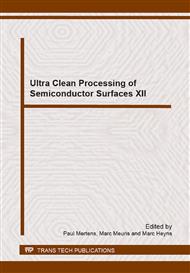p.56
p.59
p.63
p.68
p.73
p.78
p.81
p.85
p.89
Process Control Challenges of Wet Etching Large MEMS Si Cavities
Abstract:
Anisotropic etching of silicon refers to the directional-dependent etching, usually by alkaline etchants like aqueous KOH, TMAH and other hydroxides like NaOH. With the strong dependence of the etch rate on crystal orientation and on etchant concentration and temperature, a large variety of silicon structures can be fabricated in a highly controllable and reproducible manner. Hence, anisotropic etching of <100> silicon has been a key process in common MEMS based technologies for realizing 3-D structures [1-4]. These structures include V-grooves for transistors, small holes for ink jets and diaphragms for MEMS pressure sensors as shown in Figure 1 [1]. The actual reaction mechanism has not been well understood and comprehensive physical and chemical models for the process have not yet been developed. With increasing numbers of MEMS applications, interest has grown in recent years for process modelling, simulation and software tools useful for the prediction of etched surface profiles [4-6].
Info:
Periodical:
Pages:
73-77
Citation:
Online since:
September 2014
Authors:
Keywords:
Price:
Сopyright:
© 2015 Trans Tech Publications Ltd. All Rights Reserved
Share:
Citation:


